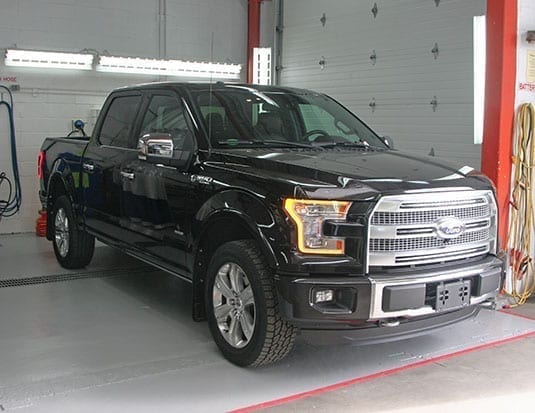With vehicles becoming more complex, providing specialized repairs at different locations can be a good strategy for MSOs.
As OEMs continue to grapple with Corporate Average Fuel Economy requirements and vehicles such as Ford’s current F-Series pickups (that utilize aircraft grade aluminum bodies), as well as a growing number of mixed material vehicles, specialized tools and repair techniques are required.
Several factors
For multi-shop operators, deciding which locations handle which kinds of repairs is becoming increasingly important. Whether it’s having major repair centres and others that deal with express repairs, or locations that specifically handle aluminum repairs, deciding how to specialize certain procedures at particular locations often comes down to several factors.
For Lorenzo Pellicciotta, who owns and operates CARSTAR Oakville and CARSTAR Oakville East, just west of Toronto, the size and configuration of each facility has dictated processes and also certain types of repairs.
“Our East location has been set up to handle aluminum repairs,” said Pelliciotta, who has made considerable investments to handle vehicles such as F-150s and also other vehicles popular in the Oakville area that use aluminum, including Jaguars and Audi A8s.
The East location was originally an assembly plant for truck axles and its galley type configuration facilitated the creation of what is essentially an assembly line operation. “We’ve got approximately 10,000 square feet at this location,” he says, “and the layout means we also have room for parts storage which we don’t have at the other location.”
Close proximity
Pelliciotta notes, however, that no matter which location a vehicle is delivered to, the fairly close proximity between both locations (12.3 km) means no matter the work, it can often be easily handled. “For precisely that reason, when we made the investments for aluminum repairs, it didn’t make sense for us to equip both locations with a specialized aluminum repair section,” he says.
Yet there are some differences. He says that the East location tends to receive vehicles that have greater damage, while the West facility tends to have more customers paying for repairs out of pocket, whether it’s minor or major.
Also, the difference in size and configuration has proved beneficial for other procedures such as ADAS calibrations. “We recently made a big investment so we can calibrate vehicle sensors in-house including ADAS systems such as adaptive cruise control, lane keep assist and cross traffic alert,” says Pelliciotta. Making the decision easier was the fact that Lorenzo also owns and operates a mechanical repair facility adjacent to his west collision location. A room that had previously been used for vehicle emissions testing has now been reconfigured for in-house scanning and calibration. Having scanning completely in-house also means that Pelliciotta has complete control of the process, meaning quality can be consistently measured, and delays resulting from outsourcing any repair needs are minimized.
Twice the size
Other MSOs that have been able to expand their business often find that a new location offers opportunities not previously available. Ken Friesen, who started and grew Concours Collision Centres in the Calgary area, built the business up to four locations. The main facility boasted 30,000 sq. ft. of space (twice that of the other locations). As a result, Friesen and his team created a rapid repair line within the main facility that allowed for smaller, more minor repairs to take place alongside bigger, more extensive repairs, for which Concours’ main location became the central hub in the network due to its size, space and proximity of mechanical repair stations.
Yet, no matter how MSOs might choose to configure different locations and provide repair services, many agree that the biggest factor in being successful comes down to staff training and task execution. “Today, you have to make sure your technicians are following OEM repair procedures,” says Lorenzo Pelliciotta. “It can sometimes be harder for older techs who are used to doing things a certain way, but these vehicles are getting so complex you can’t afford to not follow instructions. You need to keep dialing in the procedures until everybody understands them.”



